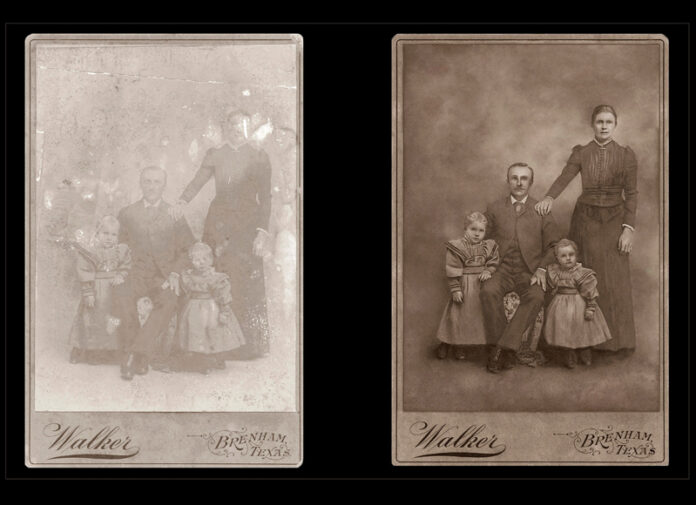by
Roy Nierdieck, M. Photog., CPP
In the realm of professional photography, the ability to restore old photographs is a unique and deeply rewarding skill. As photographers and digital artists, we hold the power to breathe new life into faded and damaged relics of the past. With the advent of sophisticated tools in Adobe Photoshop, including the powerful Neural Filters, the restoration process has never been more precise or fulfilling. In this article, we’ll delve into the techniques and tools necessary for reviving these treasured images and explore the profound joy it brings to clients when their historical memories are brought back to life.
Old photographs often bear the marks of time – faded colors, scratches, tears, and discoloration. Restoring these images involves more than mere touch-ups; it requires a careful balance of artistic intuition and technical skill. Often, the original details are lost or obscured, necessitating extensive research and creative problem-solving to recreate missing elements accurately.
Understanding the Damage – Before diving into Photoshop, it’s crucial to assess the extent of damage to the photograph. Identifying the type of deterioration – whether it’s fading, discoloration, or physical damage – will guide your approach. In many cases, you’ll need to find authentic components to replace missing or indistinguishable parts. This might involve researching historical context, consulting reference images, or leveraging similar photos from the same era. Once that assessment is made, there are some Photoshop tools that are essential in the restoration process.
Spot Healing Brush Tool and Healing Brush Tool – The Spot Healing Brush Tool is perfect for removing small blemishes and scratches. Its ability to automatically sample surrounding areas makes it an excellent starting point for clean-up. For more control, the Healing Brush Tool allows you to manually select a source area to blend with the target area, which is particularly useful for repairing more significant damage.
Clone Stamp Tool – The Clone Stamp Tool provides greater control when duplicating specific areas of an image. It’s invaluable for reconstructing missing parts of a photograph. By carefully cloning adjacent areas, you can seamlessly fill gaps and recreate lost details with precision.
Patch Tool – The Patch Tool is ideal for larger areas of damage. It lets you select and move a specific part of the image to cover another damaged section. Photoshop will blend the texture and lighting of the patched area with the surrounding pixels, ensuring a natural look.
Color Correction Tools – Restoring color in faded photographs is often the most challenging aspect. Use the Levels and Curves adjustment layers to correct brightness and contrast. The Hue/Saturation adjustment layer helps in tweaking colors to match the original tones.
Neural Filters – One of the most exciting developments in Photoshop is the introduction of Neural Filters. These AI-powered tools can enhance and upscale images, apply colorization, and even reconstruct facial details. For faded photos, the Colorize Neural Filter can add realistic colors to black-and-white images, while the Enhance filter can improve overall clarity and detail. These filters are especially useful for photographs where the original colors are completely lost.
Smart Objects and Non-Destructive Editing – Utilizing Smart Objects ensures that your edits remain non-destructive, allowing you to make changes without altering the original image. This flexibility is crucial in restoration work, where you may need to revisit and refine various elements over time.
I became interested in photo restoration when I decided to write a family history. I had a large number of family photos inherited from my parents, grandparents, aunts and uncles, and friends who passed them on to me. In looking through all the photos, I found many needed some amount of restoration in order to be used. I also thought it would be another avenue to help me progress to a Master Artist degree.
My first successful attempt was of my parents’ wedding picture (below). What I thought initially, would be a little spot healing brush, patch tool and color correction work turned out to be a major project. I discovered that as you correct one area, other flaws and more damage becomes evident. After entry into numerous image competitions and one judge after another pointing out additional flaws, I finally achieved my first merit image at the 2021 IPC with this photo.
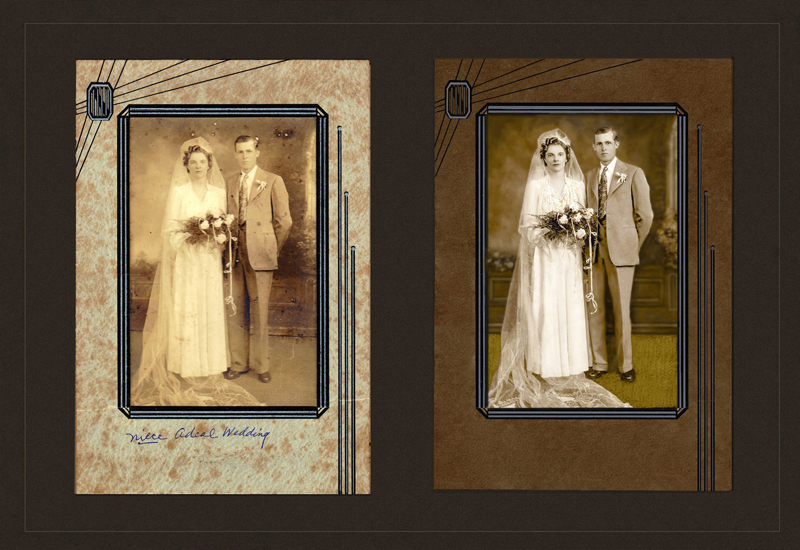
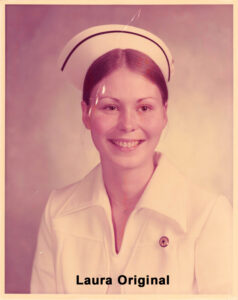
You can use this skill to affect people’s lives even on fairly recent photos that have deteriorated. A very good friend of mine sent me a photo of his wife’s nursing school graduation photo (Laura – Original). He said “Can you just remove the scratches and clean it up a little?” I used the Neural Filters available in Photoshop, and the result illustrates that there is no “quick fix” tool for most cases (Laura – first pass).
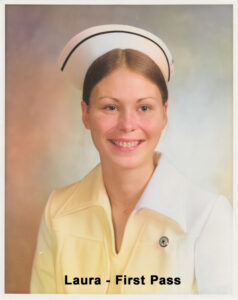 Using many of the other available Photoshop tools, as well as determining her eye color and obtaining an accurate description of the nursing pin, I was able to present him a finished image (Laura – final). When he gave her the photo for their anniversary, he said she literally cried for joy. He said “I don’t think I could have given her jewelry or any other material gift that would have brought her more happiness.”
Using many of the other available Photoshop tools, as well as determining her eye color and obtaining an accurate description of the nursing pin, I was able to present him a finished image (Laura – final). When he gave her the photo for their anniversary, he said she literally cried for joy. He said “I don’t think I could have given her jewelry or any other material gift that would have brought her more happiness.”
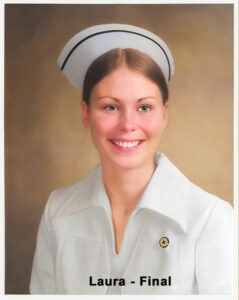
My crowning achievement came with the discovery of a 125-year-old photo of my grandmother when she was a child. The photo was in very bad shape being faded, scratched and with some faces indistinguishable. This called for the use of almost every available tool in Photoshop. I also researched other photos from the era to get authentic images of shoes and dress to reproduce. It took almost a year of work, but after entering many competitions and getting judges feedback and critiques, receiving advice and suggestions from other artists, it finally merited at IPC with an Imaging Excellence designation. It also received 1st place, Best Restoration Photo at TPPA and was also a finalist for Grand imaging Award. The best award, however, was the satisfaction of bringing a dear family member, and an important part of my history, back to life for myself and the rest of my family.
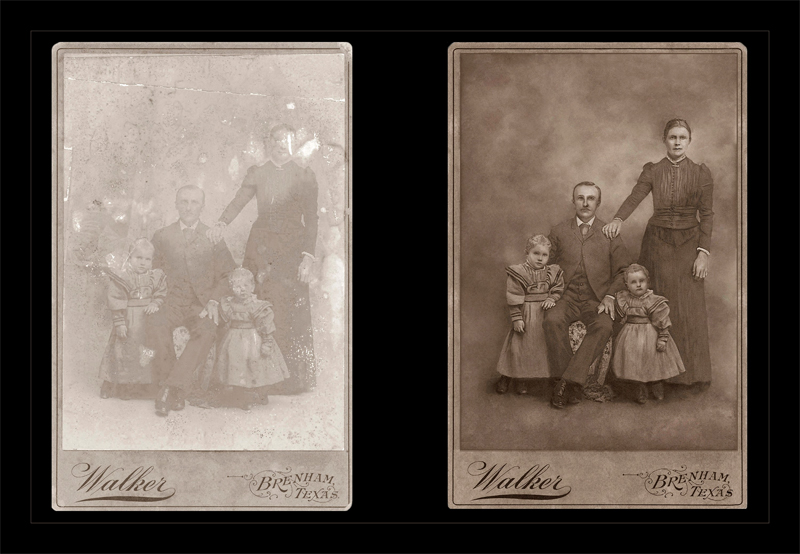
Restoring old photographs isn’t just about technical skill; it’s also about emotional impact. Clients often bring these images to you with a deep sense of nostalgia and longing. Seeing their ancestors, childhood memories, or significant historical events revived and preserved can evoke a profound emotional response. The joy on a client’s face when they see their family history brought back to life is immeasurable. It’s a reminder of the power of photography to connect us with our past and preserve our legacy for future generations.
The art of restoring old photographs is a blend of history, artistry, and technology. By mastering Photoshop’s extensive toolkit, including the advanced Neural Filters, you can transform faded and damaged images into vibrant, timeless memories. The process requires patience and a keen eye for detail, but the satisfaction of delivering restored photos that bring historical moments back to life is unmatched. As you embark on your next restoration project, remember that your work does more than fix images – it revives the stories and emotions captured within them.
By embracing these tools and techniques, you’re not only honing your skills but also contributing to preserving the rich tapestry of our shared history.
 Roy Nierdieck is a Master Photographer and Certified Professional Photographer, and owner of Red Dragon Photography in Lakeway, Texas, and has a studio location in Hearne, Texas. He is currently a Director for TPPA and is active in image competition, having received gold and platinum medals in in International Photo Competition as well as being a finalist for the Grand Imaging Award and a Silver Medalist winner, not to mention 2021 Austin Photographer of the Year. Roy is a graduate of Texas A&M University where he worked as a photographer during his undergraduate studies there. Learn more about Roy at www.RedDragonPhotos.com.
Roy Nierdieck is a Master Photographer and Certified Professional Photographer, and owner of Red Dragon Photography in Lakeway, Texas, and has a studio location in Hearne, Texas. He is currently a Director for TPPA and is active in image competition, having received gold and platinum medals in in International Photo Competition as well as being a finalist for the Grand Imaging Award and a Silver Medalist winner, not to mention 2021 Austin Photographer of the Year. Roy is a graduate of Texas A&M University where he worked as a photographer during his undergraduate studies there. Learn more about Roy at www.RedDragonPhotos.com.



